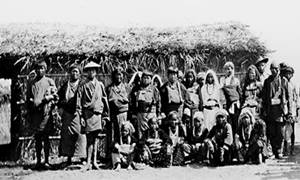The People
The Peoples of Bhutan
are known to its inhabitants in three compositions.Buddist, Hindusm and Christien
and three

|
main ethnic groups - the
Ngalong in the west, the Sharchhop in the east, and the
Nepalese origin in the south-comprise 85 per cent of the total
population. The Sharchhop and the people of central Bhutan
have their origins to the east of the Bhutan. They were
conquered by the Ngalong, who came from Tibet, early on in
Bhutan's history. All now show a fair measure of cultural
unity as Drukpas (The Buddhist peoples who
inhabit its highland areas
are known collectively as Drukpas). They share the same religious faith and
speak closely related languages, although the Ngalong tend to
dominate the religion politically even though Nepalese people
are more than 50 percent of the total population in the
country. In addition, their language, Dzongkha is declared as
the national language. Before the dictatorship of present
king, there were three official languages, Dzongkha, Nepali
and English. After 1989, they declined the Nepali language as
official language.Some 19 languages are
spoken throughout Bhutan.
The Nepali-speaking people of the
south were settled in Bhutan from the late 1800's onward. Most
of them practice Hinduism, although some are Buddhist and
Christian. They originally spoke a variety of languages, but
the Nepali language has displaced them. Lacking census data,
the Bhutanese government could for many years only estimate
the size and ethnic composition of the population of Bhutan.
In 1979, it gave a figure of 1.2 million. In 1988, the
published figure was 1.375 million. However, in 1991,
following a more detailed survey, the figure was drastically
reduced to 600,000. It is probable that none of the main
ethnic groups is in a majority. Estimates for the Ngalong vary
from 15 per cent, for the Sharchhop 30 to 32 per cent, and for
the Nepalis 50 to 52 per cent. All figures should be treated
with caution. Lacking census data,
the Bhutanese government could for many years only estimate
the size and ethnic composition of the population of Bhutan.
In 1979, it gave a figure of 1.2 million. In 1988, the
published figure was 1.375 million. However, in 1991,
following a more detailed survey, the figure was drastically
reduced to 600,000. It is probable that none of the main
ethnic groups is in a majority. Estimates for the Ngalong vary
from 15 per cent, for the Sharchhop 30 to 32 per cent, and for
the Nepalis 50 to 52 per cent. All figures should be treated
with caution.
Bhutan's culture has evolved over the
centuries and developed its own distinct characteristics.
Nonetheless, it came originally from Tibet,
and until the
early 1900s, Bhutan looked toward Tibet as a commercial
partner. The majority of the Bhutan's trade was carried out
over the Himalayan passes to the north. The south of Bhutan,
bordering the plains of India, remained an undeveloped region
behind the ruler's backs. In the early 1800s, after arrival of
Nepalese people, the south Bhutan became gold. They cleaned up
the very dangerous big forest and developed well. Finally, the
south Bhutan that used to be a big fear of disease to Drukpa
once upon a time, before arrival of Nepalese speaking people,
became a big money earner place because of development
afforded by Nepalese people. The British began to make their
presence felt and Bhutan had to begin setting up completely
new, foreign links. Inside Bhutan, there was a struggle
between those who wished to maintain the traditional
connections with Tibet and those who felt that Bhutan's
fortunes depended on links with the British at that
time.
|